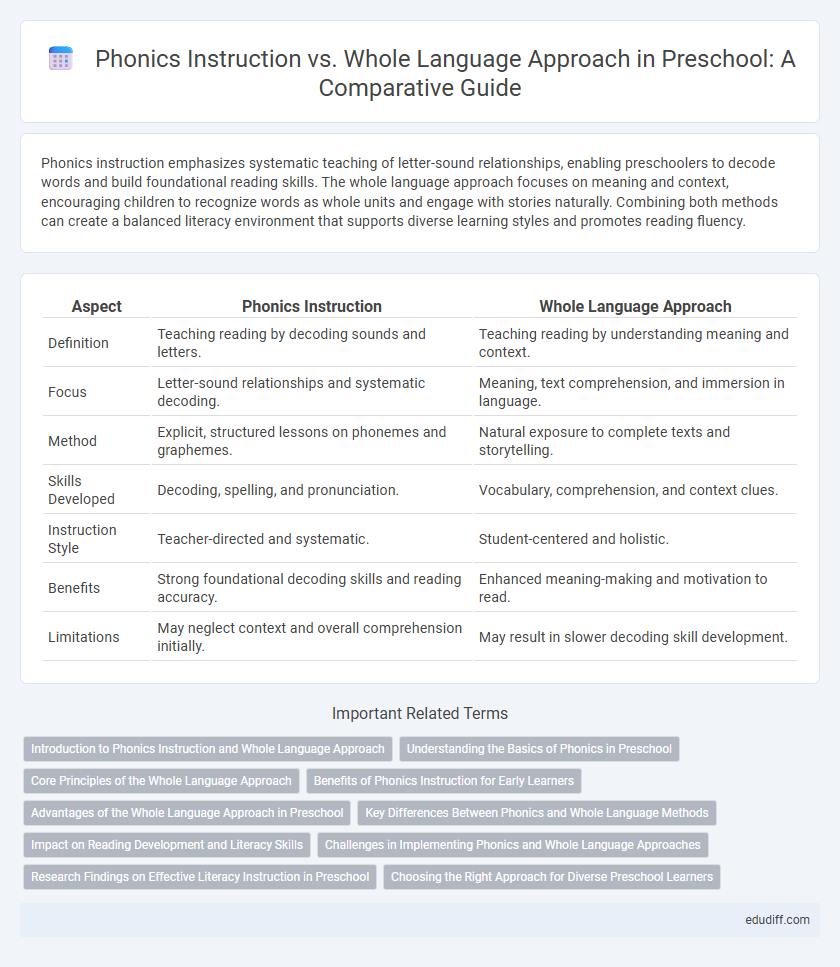Phonics instruction emphasizes systematic teaching of letter-sound relationships, enabling preschoolers to decode words and build foundational reading skills. The whole language approach focuses on meaning and context, encouraging children to recognize words as whole units and engage with stories naturally. Combining both methods can create a balanced literacy environment that supports diverse learning styles and promotes reading fluency.
Table of Comparison
| Aspect | Phonics Instruction | Whole Language Approach |
|---|---|---|
| Definition | Teaching reading by decoding sounds and letters. | Teaching reading by understanding meaning and context. |
| Focus | Letter-sound relationships and systematic decoding. | Meaning, text comprehension, and immersion in language. |
| Method | Explicit, structured lessons on phonemes and graphemes. | Natural exposure to complete texts and storytelling. |
| Skills Developed | Decoding, spelling, and pronunciation. | Vocabulary, comprehension, and context clues. |
| Instruction Style | Teacher-directed and systematic. | Student-centered and holistic. |
| Benefits | Strong foundational decoding skills and reading accuracy. | Enhanced meaning-making and motivation to read. |
| Limitations | May neglect context and overall comprehension initially. | May result in slower decoding skill development. |
Introduction to Phonics Instruction and Whole Language Approach
Phonics instruction systematically teaches preschoolers the relationships between letters and sounds, enabling them to decode words effectively. In contrast, the Whole Language approach immerses children in rich, meaningful text experiences to develop reading skills through context and comprehension. Both methods aim to build early literacy, but phonics emphasizes explicit skill-building while whole language fosters natural language acquisition.
Understanding the Basics of Phonics in Preschool
Phonics instruction in preschool emphasizes systematic teaching of letter-sound relationships to build foundational reading skills, promoting early decoding and word recognition. This approach supports children's ability to connect sounds with letters, enhancing phonemic awareness crucial for reading proficiency. In contrast, the whole language approach prioritizes exposure to meaningful texts and context, but understanding phonics basics ensures a balanced literacy development in young learners.
Core Principles of the Whole Language Approach
The Whole Language Approach emphasizes meaning and context by integrating reading with speaking, listening, and writing, promoting literacy through exposure to authentic texts rather than isolated phonics drills. It encourages children to use language naturally in meaningful communication, fostering comprehension and critical thinking skills by recognizing words as part of a larger linguistic system. This holistic method contrasts with phonics instruction's focus on decoding and phoneme-grapheme relationships, prioritizing literacy development through immersion in rich, real-world language experiences.
Benefits of Phonics Instruction for Early Learners
Phonics instruction enhances early learners' decoding skills by explicitly teaching letter-sound relationships, which supports fluent reading and spelling development. Research shows that systematic phonics instruction improves word recognition, reading accuracy, and comprehension, especially for children at risk of reading difficulties. Early mastery of phonics also builds confidence and motivation, fostering a strong foundation for lifelong literacy success.
Advantages of the Whole Language Approach in Preschool
The Whole Language Approach in preschool fosters natural reading development by integrating literacy into meaningful, context-rich activities that engage children's interests and promote comprehension skills. This approach encourages children to recognize words and phrases as wholes, enhancing language immersion and making reading a more enjoyable, authentic experience. Emphasizing storytelling, discussion, and environmental print supports vocabulary growth and critical thinking, aligning with developmental readiness rather than isolated phonetic drills.
Key Differences Between Phonics and Whole Language Methods
Phonics instruction emphasizes systematic teaching of letter-sound relationships to develop decoding skills, while the whole language approach relies on contextual reading and exposure to complete texts for language acquisition. Phonics provides explicit skill-building in phonemic awareness and word recognition, whereas whole language promotes immersive learning through storytelling and meaningful reading experiences. Research shows phonics improves early reading accuracy and fluency, but whole language supports comprehension and motivation by integrating reading with rich literary content.
Impact on Reading Development and Literacy Skills
Phonics instruction emphasizes systematic teaching of letter-sound relationships, which significantly improves decoding skills and early reading fluency in preschool children. The whole language approach fosters comprehension and contextual understanding by encouraging exposure to authentic texts and print-rich environments, enhancing vocabulary and narrative skills. Combining both methods can optimize literacy development by balancing the mechanical aspects of reading with meaningful language experiences.
Challenges in Implementing Phonics and Whole Language Approaches
Implementing phonics instruction in preschool faces challenges such as ensuring age-appropriate, systematic decoding skill development while maintaining engagement for young learners. Whole language approaches struggle with balancing literacy immersion and meaningful context without explicit phonemic awareness training, potentially hindering foundational reading skills. Both methods require tailored strategies to address diverse learning paces and educator expertise gaps, impacting early literacy outcomes.
Research Findings on Effective Literacy Instruction in Preschool
Research on effective literacy instruction in preschool highlights that phonics instruction significantly improves early reading skills by systematically teaching letter-sound relationships, fostering decoding abilities essential for literacy development. Studies indicate that a phonics-based approach leads to stronger word recognition and reading fluency compared to the whole language approach, which emphasizes context and meaning over explicit phonemic awareness. Integrating phonics with meaningful language experiences enhances preschoolers' overall literacy outcomes by combining structured skill acquisition with rich language exposure.
Choosing the Right Approach for Diverse Preschool Learners
Phonics instruction emphasizes systematic teaching of letter-sound relationships, promoting decoding skills essential for early reading development. The whole language approach focuses on meaning and context, encouraging children to recognize words as whole pieces of language in authentic reading experiences. Selecting the right approach for diverse preschool learners involves assessing individual needs, language backgrounds, and cognitive readiness to create a balanced literacy framework that supports both decoding and comprehension.
Phonics instruction vs Whole language approach Infographic

 edudiff.com
edudiff.com